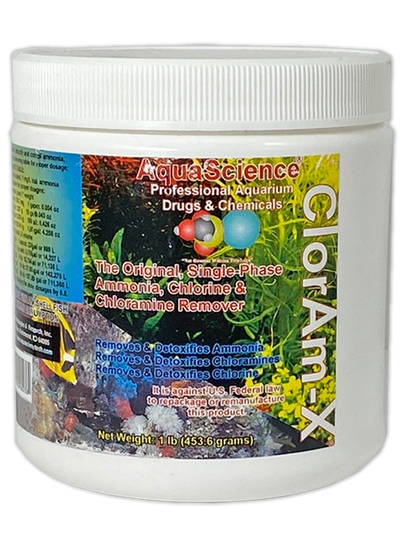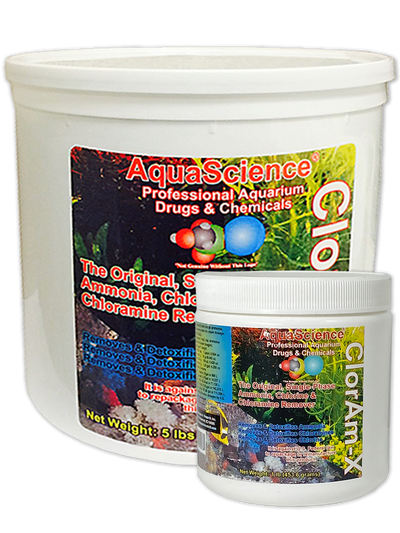


ClorAm-X®
ClorAm-X is a dry powder water conditioner and ammonia and chlorine neutralizer . It detoxifies and removes ammonia, chlorine and chloramines in both fresh and saltwater.
Product Description
Benefits
 Safer Than Other Neutralizers
Safer Than Other Neutralizers
You can over-dose 10x the recommended dosage amount safely. Tested with fish, shrimp, shellfish, aquatic invertebrates.
 Ship Live Animals Without Toxic Ammonia Problems for 72+ Hours
Ship Live Animals Without Toxic Ammonia Problems for 72+ Hours
Used around the world for bulk live transport of fish, shrimp, and shellfish. By reducing the amount of free ammonia in the water, transportation times can be significantly longer without injury to the animals.
 Increases Rotifer Production
Increases Rotifer Production
Ammonia toxicity is one of the biggest challenges with intensive cultures such as rotifer production. Rotifers have a very high metabolism and produce a lot of waste which change into ammonia and can quickly reach toxic levels. We use ClorAm-X in our rotifer grow-out tanks and achieve up to a 40% increase in productivity.
 Value
Value
ClorAm-X is less expensive than other company's products.
 Effective Biofilter Replacement / Enhancement
Effective Biofilter Replacement / Enhancement
ClorAm-X can completely replace the biofilter in a 90% recirculating system. It can be used to enhance biofiltration in any system since it will not disrupt the natural biofilter.
Use and Storage
Directions
For 1 ppm (1mg/L) total ammonia, add 31 mg of ClorAm-X per liter or 120.7 mg of ClorAm-X per gallon.
Enter values in the table below to calculate the amount of ClorAm-X to use for specific volumes of water. . .
Fish Food Use
ClorAm-X may be used on fishes intended for human consumption. The United States Food & Drug Administration (FDA) has determined that the use of the chemical that constitutes ClorAm-X (sodium hydroxymethanesulfonate) in water with fishes, intended for human consumption, does not come under FDA jurisdiction. Click here for a pdf of the FDA's "letter of determination"
Use with Shellfish
As with fishes intended for human consumption, ClorAm-X may be used on shellfish intended for human consumption. In the FDA's "letter of determination", the agency states that the use of the chemical that constitutes ClorAm-X, in water with aquatic invertebrates (e.g. lobsters, shrimp, crabs, clams, oysters) intended for human consumption, does not come under FDA jurisdiction. Our double blind toxicology studies were conducted on Homarus americanus, American lobsters, by Dr. Paul Cheung of the Osborne Marine Institute (Brooklyn, NY) and by Leberco Laboratories (NJ). The results of these studies were a part of the materials submitted to the FDA when we requested a determination of the product's legal status with regard to its use on aquatic animals intended for human consumption. For a copy of the FDA's "letter of determination" please contact us.
MARINE INVERTEBRATES: During the development of ClorAm-X, successful shipping tests were conducted with a wide variety of marine invertebrates: shrimp (e.g. penaeids and Stenopus hispidus), Octopus bimaculoides, American lobster, Turbo and Conus snails, Aplysia, various squid species, tropical and cold-water sea stars and sea cucumbers, Metridium and Condylactis anemones, and hermatypic corals (e.g. Trachyphyllia geoffroyi). Additionally, over the years that ClorAm-X has been on the market, it has been used commercially by soft-shell crab distributors to prevent ammonia accumulation during the period the crabs are held before and during their molting.
FRESHWATER INVERTEBRATES: ClorAm-X has also been extensively tested with freshwater mollusks and crustaceans. These have included species of snails, shrimp and crayfish. The product is routinely used for ammonia control in the shipments of both freshwater and marine invertebrates intended for the aquarium and bait trades.
LIVE FISH FOODS: ClorAm-X is routinely used in the packaging and shipping of live aquatic invertebrates sold as live fish feeds. Brine shrimp (Artemia spp. ), glassworms, bloodworms, blackworms, Daphnia spp. , etc. , have been, and currently, are being held, shipped and packaged in water treated with ClorAm-X.
Academic and Research Use
ClorAm-X is used extensively by researchers doing remote field research where the collection, holding and transportation of live fish and invertebrate specimens is both necessary and difficult. When collected animals are held in water treated with ClorAm-X the effects of ammonia are eliminated. When used in shipping water the effects of ammonia and shipping stress are eliminated or mitigated. For shipping, the used of breathable bags greatly enhances the survivability (during and after shipping) of both fishes and invertebrates. For more information on the use of ClorAm-X on collecting expeditions please contact our scientific staff.
Contraindications
ClorAm-X is not a medication, chemotherapeutic agent nor an economic poison and is not indicated for the treatment or control of any specific or general disease condition in aquarium organisms nor for the control of any pests.
If used to remove large concentrations of ammonia (>1.0 mg/L as Nh2) in water with little (<50 mg/L as CaCO3) or no alkalinity the pH should be monitored. If the pH declines (by more than 0.3 units) simply add sufficient sodium bicarbonate (baking soda) to boost both the pH and the alkalinity.
Stability
ClorAm-X is stable for an indefinite period if kept in its original container. ClorAm-X should be kept dry, but if the powder forms lumps from having been exposed to humid air, the lumps can be pulverized, as necessary, and the product can be used as before. Do not return unused portions to the original container; do not introduce any water or other chemicals into the container.
Compatiblities
WITH OTHER WATER ADDITIVES: ClorAm-X is compatible with most other water conditioners. It is incompatible with strong oxidizing agents such as potassium permanganate (KMnO4) and its solutions. Due to its ability to reduce certain dyes ClorAm-X should not be used with treatments containing malachite green or methylene blue or related dyes. ClorAm-X is compatible with most antibiotics. ClorAm-X can be added directly to recirculating systems with active biological filtration; it will not interfere with, nor short-circuit, the nitrification process.
WITH TEST KITS: Water treated with ClorAm-X will give false (high), off-scale readings with ammonia test kits that use Nessler's reagents. Water treated with ClorAm-X is compatible with most salicylate and phenol/hypochlorite test kits. Contact AquaScience if there is a question about ammonia test kit compatibilities.
Water treated with ClorAm-X is compatible with all known nitrite and low-range nitrate test kits.
Water treated with ClorAm-X is incompatible with Winkler and modified Winkler dissolved oxygen (DO) test kits. These kits will give false, low, or zero, readings. However, water treated with ClorAm-X is compatible with indigo/carmine dissolved oxygen test kits and with dissolved oxygen meters.
WITH COLORIMETERS: Refer to the information above about test kit reagent compatibility. AquaScience has valuable information about ammonia testing using colorimeters and methods which require the use of a blank determination; please contact us for details.
WITH ELECTRONIC METERS AND ISE'S: When testing treated water with an ammonia ion-specific electrode (ISE) and electronic meter omit the step where 10N sodium hydroxide solution is added. Instead, dilute the electrode's picric acid filling solution with deionized water (to increase the electrode's sensitivity) at a ratio of 1 (filling solution) : 9 (deionized water), by volume, and measure the free ammonia directly. Refer to available charts to calculate the total ammonia from the free ammonia value determined and the known temperature, pH and salinity. Contact AquaScience for more information about how to do measurements with an ammonia ISE in water treated with ClorAm-X.
Toxicites
ClorAm-X is not known to be toxic to any fishes, amphibians, aquatic invertebrates or aquatic plants.
Solutions containing approximately 21% ClorAm-X have been shown to be nontoxic and nonirritating to humans. Acute mammalian toxicity tests were performed on rats and skin and eye irritation (Draize tests) were performed on rabbits. The tested solutions of ClorAm-X were found to be nontoxic at oral doses of 5,000 mg/Kg or less.
Double blind toxicities studies were performed on American lobsters to determine if toxic metabolites accumulated in the edible tissues of the lobsters. No significant differences were found, in aqueous and ether extracts of the lobsters' edible tissue, between exposed and unexposed (control) animals.
Packaging
ClorAm-X is packaged in two convenient sizes: 5 lb and 10 lb tubs.
Technical Info
Water Conditioning: General Considerations
Water conditioning is the process of altering water so that aquatic life can survive and thrive in it. Municipal water sources are treated so that the water delivered to the tap is free of viable disease-causing bacteria, viruses and other organisms as well as appearing clean and clear and being free of disagreeable odors and flavors. While such water is typically suitable for human consumption with no further treatment it is almost always quite deadly to aquatic life.
In broad terms, a water conditioner must remove or mitigate those substances which are toxic to aquatic life and add those substances which promote the health and well being of aquatic life. ClorAm-X is just such a water conditioner and continues the long tradition of powerful and safe water conditioners developed and distributed by AquaScience Research Group, Inc.
Water Conditioning: Specific Considerations
Water from different sources will have different problems which need to be corrected before it can be safely used for aquariums and ponds.
CHLORINE: This is the most commonly used disinfectant substance found in tap water in the world. This is because it is highly effective and inexpensive and the technology, in water treatment, is well documented and understood. The chlorine content of any water sample can be easily determined with available chlorine test kits. The best kind of kit is one which will give two different, but related, measurements: (1) "free, available chlorine" and (2) "combined available chlorine".
In the United States the federal Environmental Protection Agency (EPA) and various federal, state and local public health agencies have required that for overall human health that the amount of trihalomethanes (mostly as chloroform, CHCl3) be significantly reduced or totally eliminated from drinking water. The source of trihalomethanes in drinking water comes mainly from the reaction of "free, available chlorine" with low levels of dissolved organic substances in the treated water.
The obvious problem with reducing "free, available chlorine" is that disease-causing organisms (e.g. polio virus, typhoid fever bacteria, and fecal coliform bacteria) would likely make it through the water treatment process and arrive at the customers' taps.
"Free, available chlorine" is known, chemically, as "hypochlorite". The hypochlorite ion, OCl-, is the same ion that is found in common, household bleach products. As every homemaker knows, bleach is one of the best disinfectants available. Some small water treatment companies even "batch treat" their water supplies by adding the required amount of industrial bleach solution to a large tank of water before it gets distributed through the water supply system. The larger water treatment companies simply add chlorine gas directly to the water treatment stream and thereby produce the hypochlorite in situ.
The actual concentration of hypochlorite in the delivered water will vary from day to day and from season to season depending upon the conditions of the feed water and how the chlorine is added to the water.
The removal of chlorine; called "dechlorination" is relatively simple and can be achieved by a number of chemical substances. In addition, when water contained almost exclusively "free, available chlorine" it could be strongly aerated for a few days at room temperature and most (but usually not all) of the chlorine would dissipate. This was called "aging" the water.
The actual chemical reaction that occurs between hypochlorite ions and ClorAm-X is illustrated in the following chemical equation:
OCl- + HOCH2SO3Na H2NCH2SO4Na + Cl-
This results in the formation of chloride, Cl- and sulfate, SO4-2 ions
As natural water sources around the US and, indeed, around the world became more and more polluted it became necessary to more aggressively treat water to insure a healthy product. This also meant adding increasing amounts of chlorine so that the water treatment agencies could insure that the chlorine residual being delivered to the customer was sufficient to maintain safe water throughout the ever aging distribution systems.
As chlorine content (as "free, available chlorine") increased so did the trihalomethane content. Trihalomethanes are known cancer-causing agents (carcinogens). To counteract the trihalomethane threat and still provide safe water is was known that by increasing the "combined, available chlorine" content one could both make the water safe and eliminate the carcinogens. "Combined, available chlorine" is better know as "chloramines".
CHLORAMINES: These substances are formed from the reaction between chlorine (or hypochlorite) and ammonia or ammonium compounds in water. There are three substances which can be called chloramines. These are (1) monochloramine, NH2Cl, (2) dichloramine, NHCl2, and (3) trichloramine, or nitrogen trichloride, NCl3. The formation of these compounds are relatively easy to understand if one looks at the ammonia molecule, NH2, which consists of a central nitrogen atom, N, with three hydrogen atoms, H, attached. Any or all three of the hydrogens can be removed in a chemical reaction and each can be replaced by a chlorine atom, Cl.
The chemical reaction between monochloramine and ClorAm-X is illustrated by the following chemical reaction:
NH2Cl + HOCH2SO3Na H2NCH2SO3Na + H+ + OCl-
The OCl- is hypochlorite. This ion then reacts with the sulfonate end of the ClorAm-X molecule for form harmless chloride ions, Cl- (see the previous section CHLORINE above).
In water treatment the first such compound, monochloramine, is the most desirable due to its stability in solution and its ability to kill viruses, bacteria and other microorganisms. In actual practice, there is always a small percentage of the total chloramine content present as dichloramine, but never any trichloramine. The trichloramine is very unstable and rapidly decomposes to free nitrogen and chlorine (that's why one should never mix bleach and household ammonia or ammonia-containing cleaners).
When dechlorinated with ordinary dechlorinators the chloramines release the bound ammonia into the water. In addition, the chloramines are resistant to dissipation, even when the water is strongly aerated. The removal, or destruction, of chloramines is called "dechloramination". There is only one substance which not only dechloraminates water, but is also stable in solution, is nontoxic and has been determined by the United States Food and Drug Administration (FDA) that it does not come under their regulation*. ClorAm-X is, therefore, suitable for use on fishes and aquatic invertebrates intended for human consumption. This substance is found in ClorAm-X and is protected by US and foreign patents.
AMMONIA: Ammonia comes from many sources in aquariums and ponds. These include accumulated and decomposing feces, uneaten food and dead plants. In aquariums, however, it has been shown that the majority of the ammonia in the water comes from the living fishes. Fishes expel ammonia directly into the water from exchange sites on their gills. This means the ammonia enters the water directly without having to be first mineralized from feces, etc. This is why starved fishes will still pollute their water with ammonia even though little or no fecal matter is produced.
The actual molecular or ionic form of the ammonia present in the water is directly dependent upon the pH, temperature and salinity. The pH is the most important factor affecting the equilibrium between molecular (= "free"), NH2, and ammonium ion (="ionic ammonia"), NH4+. As the pH increases the percentage of molecular ammonia increases, and as the pH decreases the percentage decreases. Another way of understanding this is to remember that at acid pH's (pH < 7) the ammonia becomes less toxic to the fishes and at alkaline pH's (pH >7) it becomes more toxic. ClorAm-X reacts with ammonia in is free, or unionized form. ClorAm-X will not only remove the "toxic ammonia" but due to the concentration present in standard dosages it will also remove all the ammonia as the equilibrium between ammonia and ammonium ion shifts as the Nh2 is consumed in the reaction. At low pH's this reaction proceeds slower than at pH's above 7, but in practical terms the reaction proceeds quickly enough to provide complete ammonia removal in an hour or less.
The actual chemical reaction between ammonia and ClorAm-X is shown below:
NH3 + HOCH2SO3Na H2NCH2SO3Na + H2O
The reaction product, H2NCH2SO3Na, an aminomethanesulfonate salt, is nontoxic and is capable of being metabolized by ammonia-oxidizing (nitrite) bacteria. If the ClorAm-X is dosed at levels higher than needed to react with the ammonia present in the treated water, the excess may react further with the aminomethanesulfonate salt. This secondary reaction, however, will proceed slower than the initial reaction, and dosing with excess ClorAm-X to react with anticipated ammonia levels, such as in shipping bags or tanks, over a long period is recommended. The aminomethanesulfonate salt is stable at pH levels less than 9.0; at higher pH levels the compound will start to react with hydroxide ions, OH-, and some free ammonia may be produced.
Unlike other water conditioner which claim to remove toxic ammonia, ClorAm-X will do so even if the pond, tank, or aquarium is not cycled, is overstocked or is improperly filtered (this is why ClorAm-X can be used in live-haul tanks and shipping bags where there is no filtration and where the number of fishes per volume of water is typically several times that found in an aquarium, tank or pond). Additionally, when using ClorAm-X to remove ammonia there is no need to do water changes nor to vigorously aerate the water to facilitate is action. This does not mean that ClorAm-X should be used instead of proper water maintenance, but when ClorAm-X is used water management is made more efficient and effective.
* FDA Letter regarding ClorAm-X
ClorAm-X Material Safety Data Sheet
Tariff Code
The United States tariff code for ClorAm-X is 3402.90.5010 - "Cleaning Products", class 55.
There should be no restrictions on importing ClorAm-X into any country. The product is non-toxic and non-hazardous.

